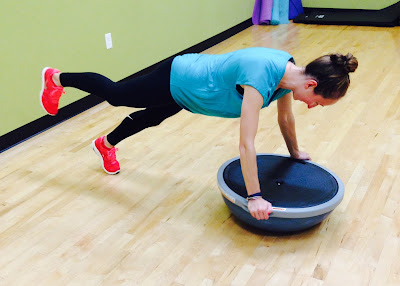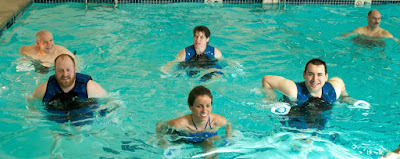Warm up before trying any of these moves. Begin with 10 repetitions each. Do not
perform any exercise that causes or increases pain.
Jack O’Lantern Squats
Begin in an upright position. Take a small hop forward, landing with soft
feet into a squat position, weight in your heels and arms raise parallel to the
ground. Stand up, lowing arms to your side and repeat 10x.
Pumpkin Lift
Begin in an upright position holding a medicine
ball. Squat down and tap the floor with
your medicine ball then stand up tall and reach the medicine ball
overhead. Practice good squat form
keeping your knees behind your toes. Repeat
10x.
Monster Walks
Tie a theraband around your legs, just above
your knees. Begin in an athletic stance
with knees slightly bent and back straight.
Take big steps forward while staying in that athletic stance and keeping
tension in the theraband. Feel the burn
in your glutes!
Double Double Toil & Trouble Leg Kicks over
Bench
For the scary version of this popular Burdenko
exercise, begin seated on a bench with both legs on one side. Sit back on your tailbone, holding a pelvic
tilt with your back straight. Hold on
the bench behind you for support. Kick
both legs straight over the bench together.
Tap the floor with your feet then repeat to the other side, alternating
for 10 repetitions.
Candy Crunches
Begin by sitting on a physioball. Walk your feet forward until the physioball
rests on your upper back, shoulders and neck hanging off the physioball ball. Keep your hipss elevated and perform a crunch
with your head and neck in a neutral position. Repeat 10 repetitions.
Vampire V-Sit
Lay on your back holding a physioball between
your feet. Pelvic tilt pressing your
lower back into the mat and lift the ball off the ground. Pass the physioball from your feet to your
hands. Continue to lower the ball to the
ground in your hands. This is a
challenging core exercise and it’s important that you only lower the ball as
far as you can hold a pelvic tilt.
Continue to pass the ball back and forth for 10 repetitions.
BOOty Bridge
Lay on your back with your heels on a
physioball. Dig your heels into the
physioball as you squeeze your glutes and lift your hips off the ground. Hold for 2-3 seconds and lower. Repeat 10x.
Spiderman Plank
Begin in a plank position. Bring your knee to
your elbow (same side) while keeping your leg parallel to the floor. Repeat on the other side, alternating for 10
repetitions.
Black Cat/Camel
Finish up your workout with this stretch for
mobility in your back.
Begin on all 4s (hands under your shoulders, knees
under your hips). Start with your back
in a neutral position then alternate between arching your spine upward toward
the ceiling (cat) and rounding your back (camel) by relaxing your back and
allowing your stomach to fall towards the ground. Repeat 10x.
Boo!
Blog post by Jen Skiba.
























